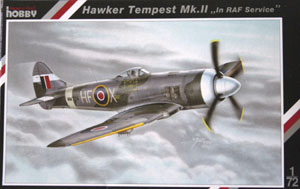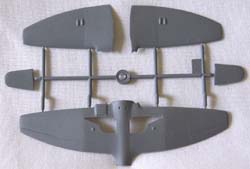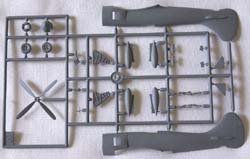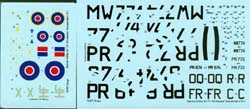Special Hobby 1/72 Hawker Tempest Mk. II
|
 |
History
The Hawker Tempest was a continuation from the Typhoon, and the Mk.II
Tempest saw the matching of a radial engine to the Tempest airframe. The
large Centaurus engine was enclosed with a tight-fitting cowl, making
the Tempest Mk.II a very streamlined airframe. This tight cowl made cooling
difficult and it was by copying the German idea of an annular oil cooler
fitted in the cowl and cooled by an impeller that the overheating problem
was solved. The Tempest Mk.II saw service mostly in the Far East, with
the RAF flying out of India. Arriving too late for much use during the
Second World War, the Tempests in India did take part in the Malayan Communist
uprising in 1947, as well as fly operations against hostile Indian tribes
in the latter half of the 1940s.
Two other countries flew the Tempest Mk.II, both being in the same region
as the RAF Tempests. Pakistan and India received surplus RAF Tempests
and both used them in skirmishes against rebel tribes in the north. Pakistan
was the last country to fly the Tempest Mk.II in active service, with
the last flight taking to the air in 1954.
The Tempest was an excellent piston-engined fighter, but the advent
of the jet engine cut its life short. While the jet fighters of the late
1940s probably weren't a match for the Tempest, later designs quickly
caught up and left even the best piston-engined fighters behind, leaving
only a memory behind.
The Kit
Special Hobby’s kit of the Tempest Mk. II is a nice combination
of resin, photoetch, and plastic. The injection parts are cleanly molded
in a light gray plastic, while the tan resin pieces provide sharp detail
where needed. The decal sheet provides three options, all British. For
those who want to branch out and build either a Pakistani or Indian example,
I’m afraid you’ll have to look elsewhere for decals.
 Starting
with the cockpit, this is almost entirely done in resin, with some photoetch
details in the usual places (instrument panel, seat belts, etc.). This
looks like it will go together quite nicely and form a well detailed box
to insert between the fuselage halves. The fuselage halves could be glued
together before fitting the cockpit, allowing you to tweak the cockpit
fit for perfection. Also fitting into the fuselage are resin inserts for
the exhaust stacks and the tailwheel well. Starting
with the cockpit, this is almost entirely done in resin, with some photoetch
details in the usual places (instrument panel, seat belts, etc.). This
looks like it will go together quite nicely and form a well detailed box
to insert between the fuselage halves. The fuselage halves could be glued
together before fitting the cockpit, allowing you to tweak the cockpit
fit for perfection. Also fitting into the fuselage are resin inserts for
the exhaust stacks and the tailwheel well.
 Moving
on to the wings, these come in three pieces. The one-piece lower wing
gets a nice resin main gear well piece, as well as resin inserts for the
leading edge vents. The lower wing incorporates part of the lower fuselage
as well, so there won’t be any problems with achieving the right
dihedral here. The tailplanes are molded as solid pieces, with a butt
joint to the fuselage. Completing the main aircraft assembly is the resin
nose piece. Moving
on to the wings, these come in three pieces. The one-piece lower wing
gets a nice resin main gear well piece, as well as resin inserts for the
leading edge vents. The lower wing incorporates part of the lower fuselage
as well, so there won’t be any problems with achieving the right
dihedral here. The tailplanes are molded as solid pieces, with a butt
joint to the fuselage. Completing the main aircraft assembly is the resin
nose piece.
 The
final assembly and detail pieces of this kit are quite nice. There is
a photoetch grill for the upper fuselage for the later examples, at a
pair of drop tanks for the wings. The landing gear gets a nice combination
of plastic struts and resin details, to create a nice looking set of legs
to put this plane on. The propeller comes in three pieces, and there are
two vacuformed canopies to allow you to screw up once. The
final assembly and detail pieces of this kit are quite nice. There is
a photoetch grill for the upper fuselage for the later examples, at a
pair of drop tanks for the wings. The landing gear gets a nice combination
of plastic struts and resin details, to create a nice looking set of legs
to put this plane on. The propeller comes in three pieces, and there are
two vacuformed canopies to allow you to screw up once.
 For
marking options, there are two aluminum examples and one camouflaged example.
The camouflaged Tempest is from No. 54 Squadron in late 1945, and features
the white SEA markings on the nose and tail. It is coded HF-X and is camouflaged
in dark green and ocean gray over medium sea gray. Both aluminum examples
are finished similarly, with a red spinner and black codes. The first
aircraft is coded FR-C and is from No. 135 Wing in Fassberg, Germany in
1948. This plane also carries a pennant under the windscreen. The final
option is coded OQ-R and is from No. 5 Squadron in India. This plane has
a black antiglare panel. The decals are well printed and include full
stenciling. For
marking options, there are two aluminum examples and one camouflaged example.
The camouflaged Tempest is from No. 54 Squadron in late 1945, and features
the white SEA markings on the nose and tail. It is coded HF-X and is camouflaged
in dark green and ocean gray over medium sea gray. Both aluminum examples
are finished similarly, with a red spinner and black codes. The first
aircraft is coded FR-C and is from No. 135 Wing in Fassberg, Germany in
1948. This plane also carries a pennant under the windscreen. The final
option is coded OQ-R and is from No. 5 Squadron in India. This plane has
a black antiglare panel. The decals are well printed and include full
stenciling.
Conclusion
This is a nice model of the Tempest Mk. II and will look great in a
lineup of Hawker fighters. The clean lines exude speed, and the simple
paint schemes further accentuate that. While this model has a fair amount
of resin in it, there really is not anything that even a novice could
not handle.
|
|
